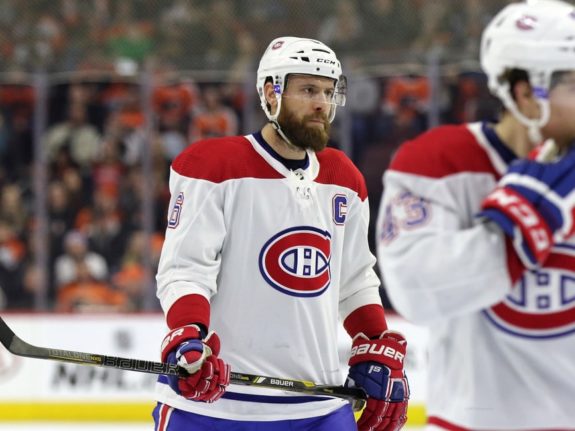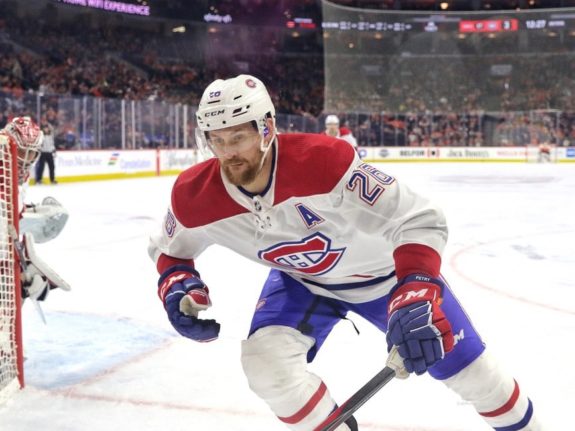It’s no secret that Montreal Canadiens’ Captain Shea Weber has lost a step or two this season. He seems slower, and – in some games – he even looks lost while defending. The Canadiens have relied on Weber to play big minutes since he was acquired in 2016 for P.K Subban, but they should manage his minutes to get the most out of his play from now on.
Weber’s Leadership Essential to Canadiens
When Weber was acquired in 2016, Canadiens’ general manager Marc Bergevin said he wanted him there for his leadership abilities (from’ Stu Cowan: Canadiens’ Shea Weber doesn’t need the ‘C’ to be a leader,’ Montreal Gazette, Oct 21, 2017). He was captain of the Nashville Predators and a leader with team Canada at the Olympics. Although Subban provided excitement and great puck-moving abilities, Bergevin wanted a more balanced defender with superb leadership abilities to change his attitude, which he felt negatively affected the room.

Weber quickly became a leader and helped the Canadiens change the culture of the Habs dressing room. Throughout the league, he is a respected player who gives the Canadiens an identity of selflessness, hard work, and teamwork that they felt they didn’t have before his arrival. As a well-respected player, along with his talent he has, he is easily a top elite defenceman on any team – at least he was.
Weber’s Respect Might Have Management Wearing Blinders
Bergevin and company look at Weber as the team leader on and off the ice and an Ambassador for the team, and he’s such a good leader on and off the ice. They hold him in high regard. This is great for a team with young players like the Canadiens, and they have a leader that can help mold the player on and off the ice and teach them as they develop with the organization. This isn’t good if the management and coaching staff allow this leadership pedestal they put Weber on to overshadow his recent play.
“Bringing a player of that calibre and culture to the Montreal Canadiens, both short term and long term; the culture stays for a long time. Players sometimes come and go, but to be able to bring a leader of that quality that’s respected not only around his own teammates but also around the league, it means a lot. I think that’s something we really had to do, and we did it. And we’re glad we did it.”
Marc Bergevin on why he wanted Shea Weber
Canadiens management and coaching staff must realize that Weber has either slowed down this season or is playing with some injury. If either one is true, then you would think that they would do something to rectify his play, unless, of course, they think so highly of him they give him free rein to call his own shots. If this is the case, then Bergevin and head coach Dominique Ducharme have put their blinders on and are hoping that Weber sorts it out himself, which is wrong for both the team and the player.
Petry Is the True Number 1 Defenceman
Jeff Petry has quietly been playing great two-way hockey for the Canadiens, consistently scoring double-digit goals and 40 plus points a season over the last four seasons. He has also been the leading point-producing defenseman for the Canadiens and has been a fairly good transitional player with his puck-moving abilities. His defensive game keeps improving, but he sometimes makes crucial errors; however, he easily makes up for those errors with great offensive play.
Related: The Beat Goes on for Canadiens’ Leading Scorer Jeff Petry [Video]
This year Petry is playing at almost a point per game production, with 27 points in 31 games, his defensive play has been steady, and he moves the puck well on the power play (PP). These are three things that Weber is not doing, yet he’s still playing on the top PP unit and getting top minutes of playing time. Petry right now is clearly the top defensemen on the team and should be getting corresponding playing time.
Canadiens Can Easily Fix Weber’s Issues
The Canadiens can easily fix weber’s issues if they are willing to do so. It can be done in any one of four ways and will not only work but also make the team and Weber better in the long run and the playoffs. The first way would be to put him on the second pairing: he can stay paired with Ben Chariot or Joel Edmundson, but he needs to be moved off the top line. This would reduce his time by about three minutes a game, which might not seem like a lot to some, but three minutes is quite a significant drop for a player, especially if it is used to 24-26 minutes a night. This would also put Petry on the top pairing and give him the minutes he deserves.

The second thing the Canadiens could do would be to pair him with better puck-moving defencemen. This could be done in several different ways: take either Brett Kulak, Alexander Romanov, or Victor Mete and put them on a line with Weber; allowing him to play better defensively and not worry about getting the puck out of the zone. Now we already know Romanov struggled with Weber on the top line, and Mete isn’t strong enough in his own end to complement Weber now as he did a few years ago, so that Kulak would be the best-case scenario on the team currently.
Related: Ranking Canadiens’ Missing Pieces to Stanley Cup Puzzle
The other two ways to better pair someone with weber is to either trade for a better defenceman or to call someone up from the Laval Rocket like Otto Leskinen, who is proving in the AHL that he is an excellent puck mover with adequate defensive abilities that could complement Weber. I wouldn’t count on the trade scenario, but Kulak and Leskinen would be better options than Chariot and Edmundson alongside Weber.
The third and fourth ways to help improve Weber’s game are the simplest of them all. One would be to rest him during busy weeks. When the team plays four games in the week or back-to-back games, have him sit out one of them; this will keep him rested, especially if the team insists on keeping him on the top pairing. Last but not least, the Canadiens can do all of the other three scenarios, put Weber on the second pairing with Kulak, and rest on back-to-back nights or weeks with four or more games in them.
No one other than Weber and the Canadiens knows why the one-time annual Norris trophy candidate is now struggling as much as he is. As I write this, I can only guess that it’s mostly fatigue due to the tight schedule. Weber is 35 years old, and it’s now time for the Canadiens to start realizing he doesn’t have the same energy as when he was 30 – which is perfectly ok if you manage his minutes as the Boston Bruins did with Zdeno Chara as he got older. If the Habs do this, they can have a productive Weber well into his contract’s twilight.